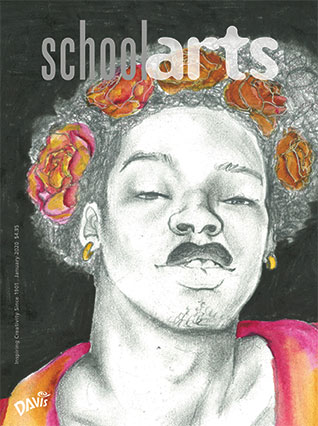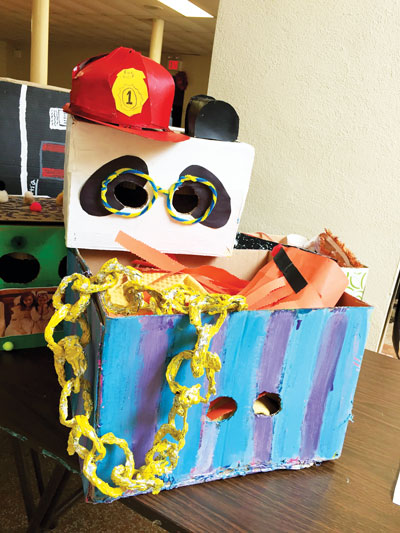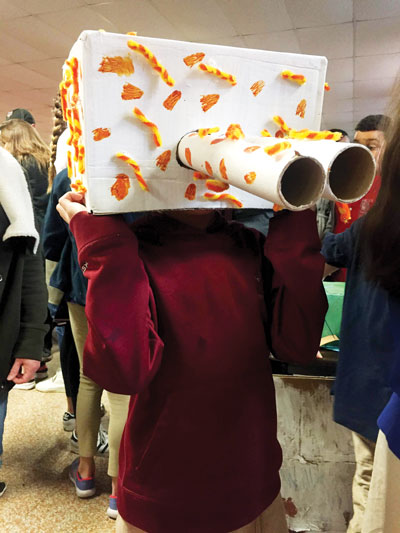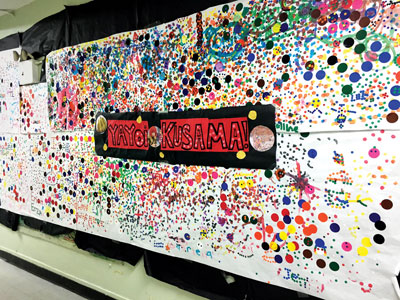 |
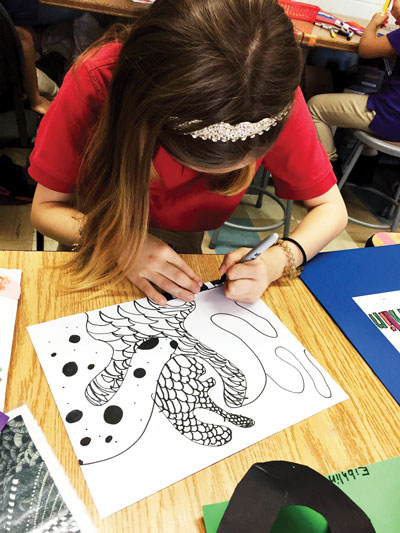 |
| Top: A polka dot installation inspired by Yayoi Kusama. Bottom: A student participates in a mindful drawing activity. |
Empathy is a complex exercise in perspective-taking, patience, understanding, and compassion. I believe that for elementary students, understanding empathy begins by bringing awareness to feelings in the first place. How can we expect our students to imagine outside of themselves until they have a better understanding of what’s happening inside first? And how might this process be different for different people?
CASEL
The Collaborative for Academic, Social, and Emotional Learning (CASEL) identifies five core competencies as a framework for looking at social and emotional learning (SEL): self-awareness, self-management, social awareness, relationship skills, and responsible decision-making.
For our youngest students, selfawareness— becoming mindful of how you are feeling—is the first step towards being able to manage and regulate those feelings. Experiencing feelings can be confusing and overwhelming for anyone, especially children, but once a feeling has a name, it can make it easier to understand and recognize in others.
Mindful Moments
As elementary art teachers, we often see our students in moments of transition when feelings (and behaviors) can be flying high. For some of us, there are other variables and challenges to consider, like teaching art on a cart and maneuvering multiple teaching environments. There’s a lot of chaos to consider in elementary school!
To create time and space to slow things down with my students, I started implementing a mindful moment at the start of every art class. We talk about how and why it’s important to get our minds and bodies ready to be creative and how becoming more aware of our feelings is an important part of that process. The characters from Pixar’s 2015 film Inside Out can be particularly helpful in illustrating these ideas with young students.
Safe Spaces
Another way to encourage selfawareness and cultivate empathy is by creating a safe space for students to identify and/or acknowledge their feelings and provide a few calming strategies. Artistic creation (especially when it involves focused, repetitive action) and activities such as mindful coloring, weaving, and collage can be powerful tools for encouraging emotional regulation.
Artist Yayoi Kusama
Last year, when creating a safe space for our art studio, my cooperating art teacher, Kendra Newell, and I were inspired by a colleague, Grace Hulse, to introduce students to Yayoi Kusama’s colorful patterns. Kusama is known for her polka dot paintings, sculptures, and mirrored Infinity installations. She describes her process of making art as a means for creating her own sense of safety in the world. Students created colorful polka dot patterns of their own, which we exhibited in the safe space in our art studio and a school installation.
Artist Heather Hansen
Heather Hansen is another artist I have shared to encourage students to think about drawing as a mindful act. Hansen is a visual and performance artist who creates large-scale drawings with her body by “dancing” on paper with charcoal in both hands. After watching some of her performance drawing videos, students were encouraged to think about drawing as a way to slow down and connect with their bodies.
Artist Nick Cave
Another artist I love to teach with is Nick Cave, who is known for his elaborate wearable sculptures called “Soundsuits.” He creates them using discarded and recycled materials, which can be a great way to introduce young students to new ways of making things. The Soundsuits are colorful, vibrant, and seemingly very playful. Cave was originally inspired to create them based on his experiences confronting racism as a black man in America.
The process of creating the Soundsuits is inherently emotional, and presents a powerful opportunity to model empathy with students, while encouraging them to dig deeper for inspiration in their own art-making.
Going Deeper
The analogy of the iceberg can be a helpful tool for illustrating the idea ofgoing deeper with young students. The tip of an iceberg is what we can see floating above the surface of the water; however, the bottom of the iceberg is always significantly more complex than what is visible at the top. By referencing the iceberg, we can ask students to consider what people know about them just by looking at them, versus all of the many thoughts, feelings, and experiences that make them who they are.
Sharing Nick Cave’s emotional process for making artwork with young students provides them with a structure for thinking more critically and bringing more awareness to what is happening inside and around them. As they start to create and share their own artwork inspired by this reflective practice, it makes the idea of sharing and understanding someone else’s feelings and experiences—that unseen part of the iceberg—much more accessible.
Reflections
We have to recognize that empathy is not a technique that can be taught one step at a time—it requires constant reflection and practice. I think it’s important that we don’t just make projects with our students around the idea of what empathy is, but that we provide them with experiences that will allow them to engage with an authentic understanding of what empathy really means.
At the end of the day, our goal as elementary art teachers is not really to train the next generation of skilled or famous artisans, but rather, to encourage little people to become good people.
Dana Joy Helwick is an art teacher at Growing Up Green Charter School in Long Island City in Queens, New York. playwithpurpose62@gmail.com
N AT ION A L S TA N DA RD
Connecting: Relating artistic ideas and work with societal, cultural, and historical content to deepen understanding.
WEB L I N K
The Collaborative for Academic, Social, and Emotional Learning: casel.org
